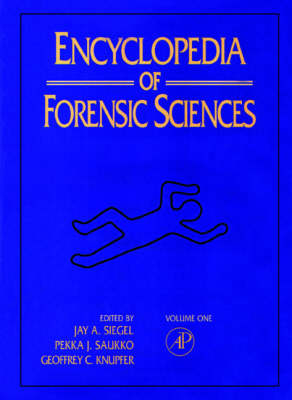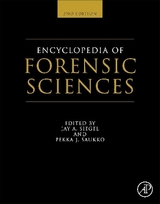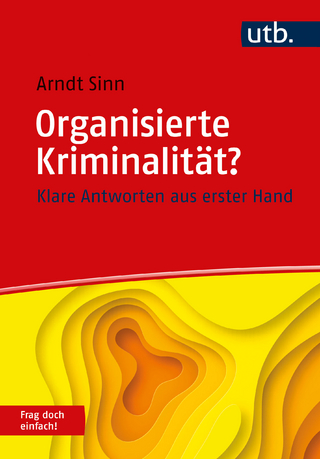
Encyclopedia of Forensic Sciences
Academic Press Inc (Verlag)
978-0-12-227215-8 (ISBN)
- Titel erscheint in neuer Auflage
- Artikel merken
The Encyclopedia of Forensic Sciences is the first resource to provide comprehensive coverage of the core theories, methods, techniques, and applications employed by forensic scientists. One of the more pressing concerns in forensic science is the collection of evidence from the crime scene and its relevance to the forensic analysis carried out in the laboratory. The Encyclopedia will serve to inform both the crime scene worker and the laboratory worker of their protocols, procedures, and limitations. The more than 200 articles contained in the Encyclopedia form a repository of core information that will be of use to instructors, students, and professionals in the criminology, legal, and law enforcement communities.
Jay Siegel, PhD is retired Director of the Forensic and Investigative Sciences Program and Chair of the Department of Chemistry and Chemical Biology at Indiana University Purdue University Indianapolis. He was Director of the Forensic Science Program at Michigan State University for 25 years from 1980-2004 until his retirement as Professor Emeritus. Dr. Siegel is a Distinguished Member of the American Academy of Forensic Sciences and was named as Distinguished Alumni Scholar by his alma mater, George Washington University in 2011. He is co-editor of Forensic Science Policy and Management: An International Journal. He was a member of the National Academy of Sciences Forensic Science Committee from 2006-09. Dr. Saukko is currently Professor of Forensic Medicine and Head of the Department of Forensic Medicine of the University of Turku, Finland. He graduated in medicine from the University of Vienna, Austria in 1975 and was certified as a Specialist in Forensic Medicine in 1981 by the National Board of Health, Finland. In 1983 he received a Doctorate in Medical Science (MD) by thesis in Forensic Pathology by the University of Oulu, Finland and was appointed Adjunct Professor of Forensic Medicine of the same University in 1986. From 1978 to 1989 he held the position of the Provincial Medical Officer, Medico-legal Expert, Provincial Government of Oulu. In 1989 he was appointed the Professor of Forensic Medicine of the University of Tampere, Finland and since 1992 he holds the current position at the University of Turku. He has published widely as an author, co-author in scientific journals, book and encyclopedia chapters and is the co-author of the “Atlas of Forensic Medicine (CD-ROM) (Elsevier Science, 2003), “Knight’s Forensic Pathology (Arnold, 2004) and “Forensic Medicine in Europe (Schmidt-Römhild, 2008). Dr. Saukko is the recipient of the Ajtai K. Sandor Medal and an Honorary Doctorate in Medicine (Dr. h.c.) from the Semmelweis University, Budapest, Hungary. His expert work as consultant includes needs assessment of the forensic facilities in Cambodia for the UNDP (1996), the Working Party on the Harmonization of Autopsy Rules for the Council of Europe (1997-1998), quality assessment of the Portuguese Departments of Forensic Pathology, as a member of an international team of experts (2001), the external case review panel for the Office of the Chief Coroner, Toronto, Canada (2006) and the consultant panel and expert witness for the Inquiry Into Pediatric Forensic Pathology In Ontario, Canada (2007) and forensic expert for the UNDP/NHRC in Kathmandu, Nepal (2008). Since 1993, he is the Editor-in-Chief of the journal Forensic Science International, by Elsevier, and Editorial Board Member of a number of other national and international scientific journals of forensic medicine and science. He is a Member of the German National Academy of Sciences Leopoldina and an Honorary Member of the Hungarian Forensic Science Society, the Royal Belgium Society of Forensic Medicine, the German Society of Legal Medicine, the Japanese Society of Legal Medicine and a Founding and Honorary Fellow of the Faculty of Forensic & Legal Medicine, Royal College of Physicians (London).
Accident Investigation (a) Aircraft. Accident Investigation (b) Motor vehicle (including biomechanics of injuries). Accident Investigation (c) Rail. Accident Investigation (d) Reconstruction. Accident Investigation (e) Airbag related injuries and deaths. Accident Investigation (f) Determination of cause. Accident Investigation (g) Driver versus passenger in motor vehicle collisions. Accident Investigation (h) Tachographs. Accreditation of Forensic Science Laboratories. Administration of Forensic Science (a) An international perspective. Administration of Forensic Science (b) Organisation of laboratories. Alcohol (a) Blood. Alcohol (b) Body fluids. Alcohol (c) Breath. Alcohol (d) Post-mortem. Alcohol (e) Interpretation. CONTENTS: Alcohol (f) Congener analysis. Analytical Techniques (a) Separation techniques. Analytical Techniques (b) Microscopy. Analytical Techniques (c) Spectroscopy. Analytical Techniques (d) Mass spectrometry. Anthropology: Archaeology. Anthropology: Skeletal Analysis (a) Overview. Anthropology: Skeletal Analysis (b) Morphological age estimation. Anthropology: Skeletal Analysis (c) Sex determination. Anthropology: Skeletal Analysis (d) Determination of racial affinity. Anthropology: Skeletal Analysis (e) Excavation/retrieval of forensic remains. Anthropology: Skeletal Analysis (f) Bone pathology and ante-mortem trauma in forensic cases. Anthropology: Skeletal Analysis (g) Skeletal trauma. Anthropology: Skeletal Analysis (h) Animal effects on human remains. Anthropology: Skeletal Analysis (i) Assessment of occupational stress. Anthropology: Skeletal Analysis (j) Stature estimation from the skeleton. Art and Antique Forgery and Fraud. Autoerotic Death. Basic Principles of Forensic Science. Biochemical Analysis (a) Capillary electrophoresis in forensic science. Biochemical Analysis (b) Capillary electrophoresis in forensic biology. Blood Identification. Blood Stain Pattern Analysis and Interpretation. Causes of Death (a) Post-mortem changes. Causes of Death (b) Sudden natural death. Causes of Death (c) Blunt injury. Causes of Death (d) Sharp injury. Causes of Death (e) Gunshot wounds. Causes of Death (f) Asphyctic deaths. Causes of Death (g) Burns and scalds. Causes of Death (h) Traffic deaths. Causes of Death (i) Systemic response to trauma. Causes of Death (j) Poisonings. Cheiloscopy. Clinical Forensic Medicine (a) Overview. Clinical Forensic Medicine (b) Defence wounds. Clinical Forensic Medicine (c) Self-inflicted injury. Clinical Forensic Medicine (d) Child abuse. Clinical Forensic Medicine (e) Sexual assault and semen persistence. Clinical Forensic Medicine (f) Evaluation of gunshot wounds. Clinical Forensic Medicine (g) Recognition of pattern injuries in domestic violence victims. Computer Crime. Credit Cards: Forgery and Fraud. Crime-Scene Investigation and Examination (a) Recording. Crime-Scene Investigation and Examination (b) Collection and chain of evidence. Crime-Scene Investigation and Examination (c) Recovery. Crime-Scene Investigation and Examination (d) Packaging. Crime-Scene Investigation and Examination (e) Preservation. Crime-Scene Investigation and Examination (f) Contamination. Crime-Scene Investigation and Examination (g) Fingerprints. Crime-Scene Investigation and Examination (h) Suspicious deaths. Crime-Scene Investigation and Examination (i) Major incident scene management. Crime-Scene Investigation and Examination (j) Serial and series crimes. Crime-Scene Investigation and Examination (k) Scene analysis/reconstruction. Crime-Scene Investigation and Examination (l) Criminal analysis. Crime-Scene Investigation and Examination (m) Decomposing and skeletonized cases. Criminal Profiling. Criminalistics. Detection of Deception. Disaster Victim Identification. DNA (a) Basic principles. DNA (b) RFLP. DNA (c) PCR. DNA (d) PCR-STR. DNA (e) Future analytical techniques. DNA (f) Paternity testing. DNA (g) Significance. DNA (h) Mitochondrial. Document Analysis (a) Handwriting. Document Analysis (b) Analytical methods. Document Analysis (c) Forgery and counterfeits. Document Analysis (d) Ink analysis. Document Analysis (e) Printer types. Document Analysis (f) Document dating. Drugs of Abuse (a) Blood. Drugs of Abuse (b) Body fluids. Drugs of Abuse (c) Ante-mortem. Drugs of Abuse (d) Post-mortem. Drugs of Abuse (e) Drugs and driving. Drugs of Abuse (f) Urine. Drugs of Abuse (g) Hair. Drugs of Abuse (h) Methods of analysis. Drugs of Abuse (i) Designer drugs. Dust. Ear Prints. Education, An International Perspective. Electronic Communication and Information. Entomology. Ethics. Evidence (a) Classification of evidence. Evidence (b)The philosophy of sequential analysis. Evidence (c) Statistical interpretation of evidence/Bayesian analysis. Expert Witnesses, Qualifications and Testimony. Explosives, Methods of Analysis. Facial Identification (a) The lineup, mugshot search and composite. Facial Identification (b) Photo image identification. Facial Identification (c) Computerized facial reconstruction. Facial Identification (d) Skull-photo superimposition. Facial Identification (e) Facial tissue thickness in facial reconstruction. Fibres (a) Types. Fibres (b) Transfer and persistence. Fibres (c) Recovery. Fibres (d) Identification and comparison. Fibres (e) Significance. Fingerprints (Dactyloscopy) (a) Visualisation. Fingerprints (Dactyloscopy) (b) Sequential treatment and enhancement. Fingerprints (Dactyloscopy) (c) Identification and classification. Fingerprints (Dactyloscopy) (d) Standards of proof. Fingerprints (Dactyloscopy) (e) Chemistry of print residue. Fire Investigation (a) Types of fire. Fire Investigation (b) Physics/Thermodynamics. Fire Investigation (c) Chemistry of fire. Fire Investigation (d) The fire scene. Fire Investigation (e) Evidence recovery. Fire Investigation (f) Fire scene patterns. Fire Investigation (g) The laboratory. Firearms (a) Types of weapons and ammunitions. Firearms (b) Range and penetration. Firearms (c) CS Gas. Firearms (df) Humane killing tools. Firearms (e) Laboratory analysis. Forensic Anthropology. Forensic Engineering. Forensic Nursing. Forensic Psycholinguistics. Forensic Toxicology (a) Overview. Forensic Toxicology (b) Methods of analysis - ante-mortem. Forensic Toxicology (c) Methods of analysis - post-mortem. Forensic Toxicology (d) Interpretation of results. Forensic Toxicology (e) Inhalants. Forensic Toxicology (f) Equine drug testing. Forgery and Fraud (a) Overview (including counterfeit currency). Forgery and Fraud (b) Auditing and accountancy. Gas Chromatography, Methodology in Forensic Sciences. Genetics (a) Serology. Genetics (b) DNA - statistical probability. Glass. Hair (a) Background. Hair (b) Hair transfer, persistence and recovery. Hair (c) Identification of human and animal hair. Hair (d) Microscopic comparison. Hair (e) Other comparison methods. Hair (f) Significance of hair evidence. Hair (g) DNA typing. Health and Safety (including Risk Assessment). History (a) Crime scene sciences. History (b) Fingerprint sciences. Identification/Individualization, Overview and Meaning. Investigative Psychology. Legal Aspects of Forensic Science. Lie Detection (Polygraph). Literature and the Forensic Sciences (a) Resources. Literature and the Forensic Sciences (b) Fiction. Microchemistry. Modus Operandi. Odontology. Offender Signature. Paints and Coatings: Commercial, Domestic and Automotive. Pathology (a) Overview. Pathology (b) Victim recovery. Pathology (c) Autopsy. Pathology (d) Preservation of evidence. Pathology (e) Post-mortem changes. Pathology (f) Post-mortem interval. Pattern Evidence (a) Footmarks (footwear). Pattern Evidence (b) Footmarks (bare footprints). Pattern Evidence (c) Shotgun ammunition on a target. Pattern Evidence (d) Tools. Pattern Evidence (e) Plastic bag striations. Pattern Evidence (f) Serial number. Pharmacology. Post-Mortem Examination, Procedures and Standards. Psychological Autopsies. Psychology and Psychiatry (a) Overview. Psychology and Psychiatry (b) Psychiatry. Psychology and Psychiatry (c) Psychology. Quality Assurance/Control. Serial Killing. Soil and Geology. Stalking. Statistical Interpretation of Evidence. Time Factor Analysis. Voice Analysis. Wildlife. Wood Analysis.
| Erscheint lt. Verlag | 24.8.2000 |
|---|---|
| Mitarbeit |
Chef-Herausgeber: Jay A. Siegel |
| Verlagsort | San Diego |
| Sprache | englisch |
| Gewicht | 5538 g |
| Themenwelt | Schulbuch / Wörterbuch ► Lexikon / Chroniken |
| Recht / Steuern ► Strafrecht ► Kriminologie | |
| ISBN-10 | 0-12-227215-3 / 0122272153 |
| ISBN-13 | 978-0-12-227215-8 / 9780122272158 |
| Zustand | Neuware |
| Haben Sie eine Frage zum Produkt? |
aus dem Bereich



